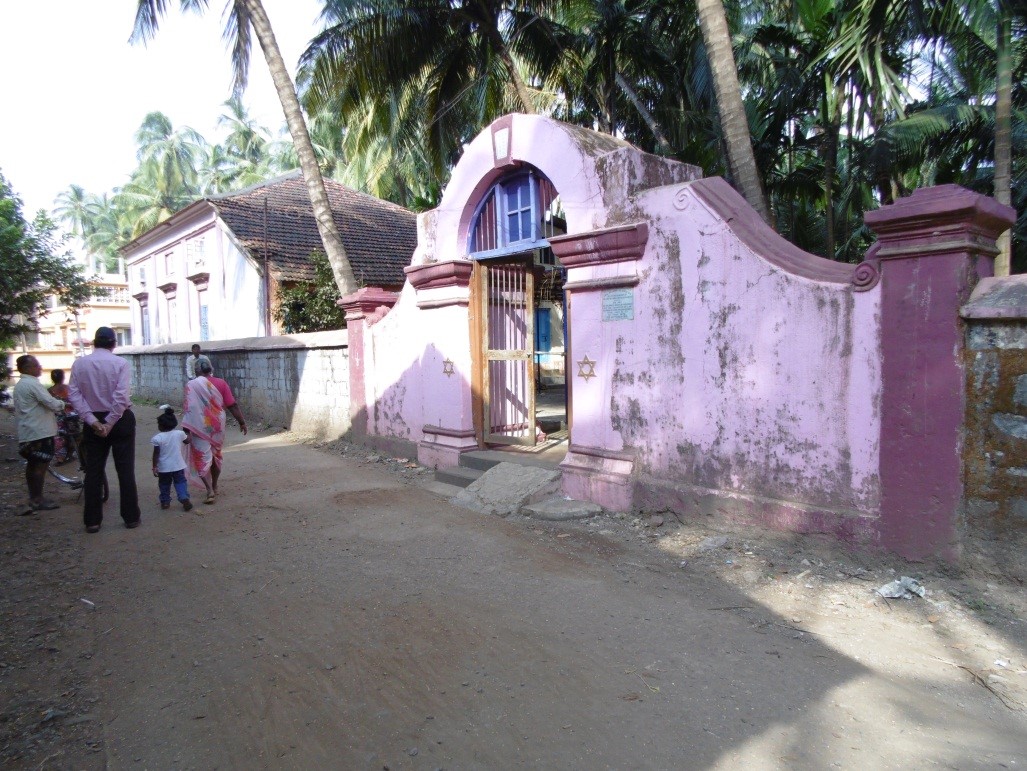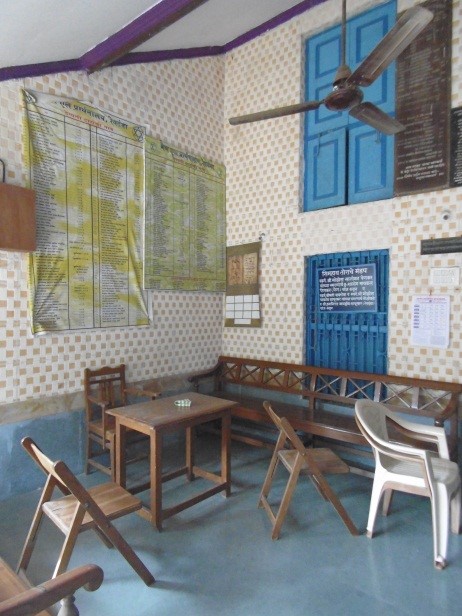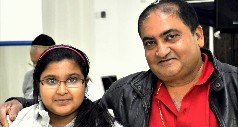BETH EL SYNAGOGUE (1848)
Zuni (Old) Post Gali (Lane) and Wadi Mohalla
Village of Rewdanda (or Revdanda)
Alibag Tehsil (municipality)
Raigad District, Konkan Region
Maharashtra, INDIA
This Raigad District/Konkan Region synagogue is today marginally functioning, although regular prayer services are not held here. Guests need to arrange in advance via the Mumbai Bene Israel community to visit the building. Contact this website for possible assistance. To reach this former synagogue and the nine others throughout the sprawling and picturesque Konkan Region, it is best to hire a car and driver from Mumbai for two full days. There is a convenient ferry that takes passengers from Mumbai’s Gate of India to Alibag in the Konkan Region. Here travelers would have to arrange for private transportation to this and other regional synagogues, which will be challenging since finding someone near the ferry jetty who knows where they are all located is difficult. The alternative is to begin in Mumbai via informed car and driver, and travel all by roads. This is the longer option but will insure that all the synagogues can be reached. For the overnight stay, the comfortable Radisson Hotel on Alibag-Pen Road, Gondhalpada, Varasoli, Alibag, Raigad is suggested.
Beth El (Hebrew for House of God), the first synagogue built in the Raigad District within the Konkan Region of coastal Maharashtra, is located in the village of Revdanda (or Rewdanda), a few hours north of Mumbai. In 1842, a modest structure was constructed with contributions from the synagogue membership. In 1848, a new and larger building replaced the earlier structure. Today it sits on a mostly unspoiled and tranquil site just away from the center of the village. The synagogue property is sizeable, containing open (unpaved) space, shrubs, and coconut trees, and the land is surrounded other small-scaled village buildings. A stone wall running along a village road is interrupted by a wide gateway finished in chunam (polished lime). The shapely gateway, with matching end pylons and undulating sections, has in its center a rounded-arch opening and a painted iron and wood gate that mark the entry to the synagogue property. The keystone and engaged pilasters at this gate are decorated with Stars of David and text identifying this as a Jewish site. Also here are inscriptions in English and Marathi revealing that the gate was dedicated in September 1912 in memory of congregant Abraham Balaji Sogavker.
A narrow path leads to the synagogue, which is today fronted by a canopy constructed of painted metal thing pipe columns and beams. Woven coconut fronds cover the canopy. The synagogue building itself is an example of the architectural vernacular of this region. The low-slung structure is constructed of simple brick walls veneered in painted chunam, which support a wood-framed roof with clay roof tiles. Along all sides of the building are corner and wall pilasters, a plain entablature, and bands of trim surrounding the windows and clerestories. Separating the clerestories and windows are small bracketed over-panels or canopies.
Beth El’s two-story porch runs along the short end of the building. Altered in recent years, the ground floor was originally a covered yet open space, but today it is partially enclosed with walls. Doors at the porch open into the sanctuary. The porch, its tiled walls not original, has a stair to the upper level, which is close to the original design. The upstairs porch is covered, and its sides are contained only by painted wood balusters. Off this area are the doors opening into the single-ended gallery where the women sat, as in other orthodox synagogues. Beth El’s other short elevation (the west side of the building) features an apse containing the heckal, or ark.
The rectangular sanctuary follows the spatial planning of other Bene Israel synagogues with its centrally-positioned raised tebah (bimah, or dedicated area containing a reader’s platform from where the Torah is read and service is led), and to the heckal (ark) on the far wall. The painted wood tebah has raised panels at its base, turned newel posts and balusters, and a shaped handrail. Projecting from the corners of the tebah are decorative brass fixtures and rods. Placed in the center of the western elevation that is closest to Jerusalem as per synagogue convention, the heckal is a wooden cabinet that is draped in the traditional cloth called the parochet. The heckal, as per synagogue tradition, is raised off the floor by a few steps. The face of the heckal wall is decorated by an arched lintel supported by matching pilasters with Corinthian-like capitals. This detail is not original to the building.
The Beth El sanctuary, which has been altered over the years in response to beautification efforts, includes light gray marble floor pavers that also run along the lower walls as a wainscot, white chunam walls, wall sconces, framed prayer verses in Hebrew, large painted wood casement windows, transoms with stained glass, and clerestories casement units. Metal grilles at the windows have been added. The trim surrounding the windows is intricate, as are the panels below some of the windows with a cusped design reflecting traditional Indian architecture. Hanging from the flat ceiling with applied trim and a Magen David (Star of David) in the center are a variety of fans, glass lanterns, and lighting fixtures. Other architectural and liturgical design features include the freestanding wooden benches along the perimeter of the sanctuary and the matching pair of draped chairs adjacent to the heckal. One is known as Elijah’s Chair, and they are used for the circumcision ceremony.
Oral history sources indicate that Bene Israel Jews are descended from ancient traders from the Middle East, who for many years conducted business in India. Eventually,-perhaps more than two millennia ago – they settled primarily in small towns and villages in the Raigad District within the Konkan Region of coastal Maharashtra. They continued to live there for centuries among larger Indian communities, as a fairly isolated disaporic Jewish enclave, following Jewish customs and lifestyle practices. Centuries later, beginning in the late seventeen hundreds but especially by the mid-1800s, many of the Bene Israel relocated to Mumbai as well as Ahmedabad, Pune, and Karachi, Pakistan when these colonial cities were expanding and offering job and lifestyle opportunities. Some remained in the Konkan region, and the synagogues continued to be religious and communal centers for many more decades.
Beginning in the mid-twentieth century, as a result of political and social changes in India, the Bene Israel, then about twenty thousand people, began to leave India, mostly for Israel. From this pattern of immigration, the Bene Israel population dropped to a few thousand, and the number of Jews currently living Konkan Region is quite small. Of the thirteen synagogue buildings built in towns and villages in this region from the mid-nineteenth to early twentieth centuries, eleven physically survive today. Of those, only a few are active houses of prayers, some endure marginally, and the balance have closed and sit empty or been converted to other functions.

Exterior

Porch








